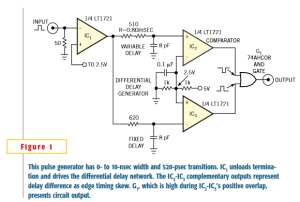Summary of Simple nanosecond-width pulse generator provides high performance
This article describes a high-speed, programmable short-time-interval pulse generator designed to produce ultra-fast output pulses ranging from 0 to 10 ns with minimal variation despite supply voltage changes. The circuit uses a quad high-speed comparator and a high-speed gate, achieving pulse widths as narrow as 700 ps at partial amplitude and 1 ns at full amplitude, with rapid rise and fall times of about 520 ps. Key features include precise pulse width control through RC networks, low input-output delay, and clean output transitions suitable for sampling and timing applications.
Parts used in the Predictably Programmable Short-Time-Interval Generator:
- Quad high-speed comparator (IC1, IC2, IC3)
- High-speed gate (G1)
- Programming resistor (RG)
- Fixed and variable RC networks
- 50Ω termination resistor

If you need to produce extremely fast pulses in response to an input and trigger, such as for sampling applications, the predictably programmable short-time-interval generator has broad uses. The circuit of Figure 1, built around a quad high-speed comparator and a high-speed gate, has settable 0- to 10 ns output width with 520 ps, 5V transitions. Pulse width varies less than 100 ps with 5V supply variations of 65%. The minimum input-trigger width is 30 ns, and input-output delay is 18 ns.
Comparator IC1 inverts the input pulse (Figure 2, Trace A) and isolates the 50Ω termination. IC1‘s output drives fixed and variable RC networks. Programming resistor RG primarily determines the networks’ charge-time difference and, hence, delay at a scale factor of approx 80Ω/ns. Comparators IC2 and IC3, arranged as complementary-output-level detectors, represent the networks’ delay difference as edge-timing skew. Trace B is IC3‘s fixed-path output, and Trace C is IC2‘s variable output. Gate G1‘s output (Trace D), which is high during IC2-IC3 positive overlap, presents the circuit output pulse. Figure 2 shows a 5V, 5ns width, measured at 50% amplitude, output pulse with R=390Ω. The pulse is clean and has well-defined transitions. Post-transition aberrations, within 8%, derive from G1‘s bond-wire inductance and an imperfect coaxial probing path. Figure 3 shows the narrowest full amplitude, 5V pulse available. Width measures 1ns at the 50% amplitude point and 1.7 ns at the base in a 3.9 GHz bandwidth. Shorter widths are available if partial amplitude pulses are acceptable. Figure 4 shows a 3.3V, 700 ps width (50%) with a 1.25 ns base. G1‘s rise time limits minimum achievable pulse width. The partial-amplitude pulse, 3.3V high, measures 700 ps with a 1.25 ns base (Figure 5). Figure 6, taken in a 3.9 GHz sampled bandpass, measures 520 ps rise time. Fall time is similar. The transition of the probe edge is well-defined and free of artifacts.
For More Details: Simple nanosecond-width pulse generator provides high performance
